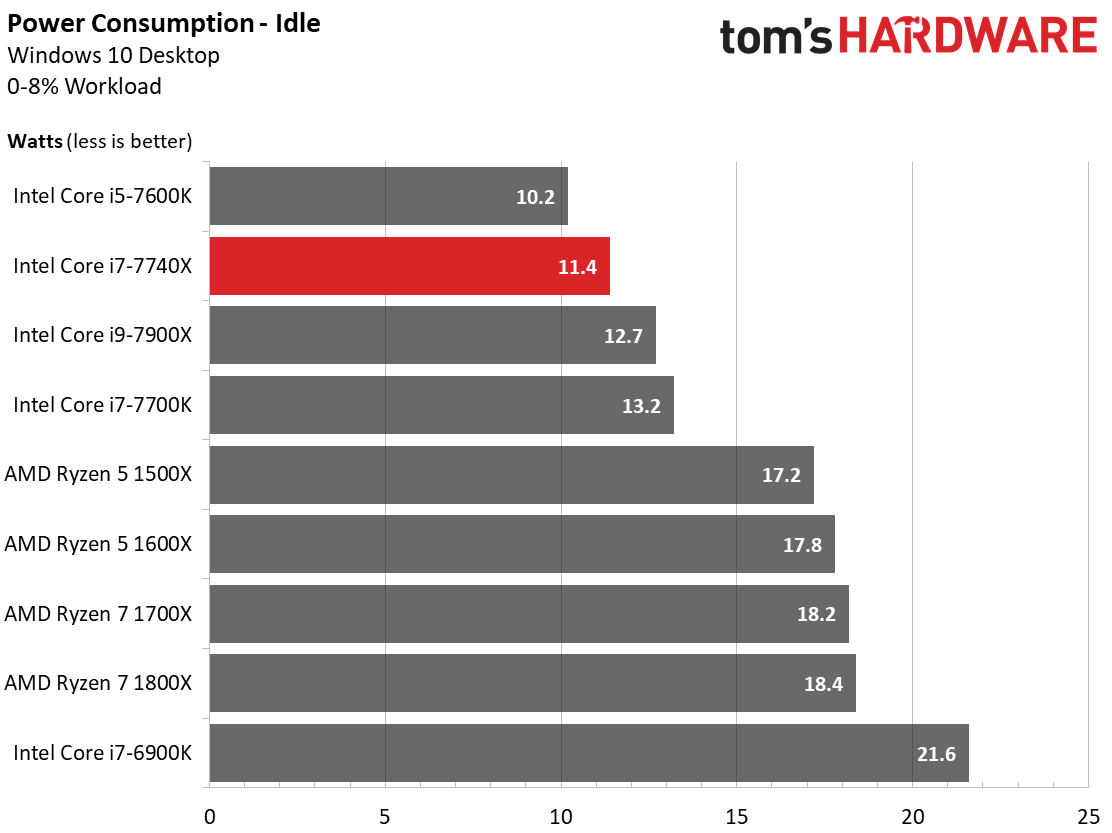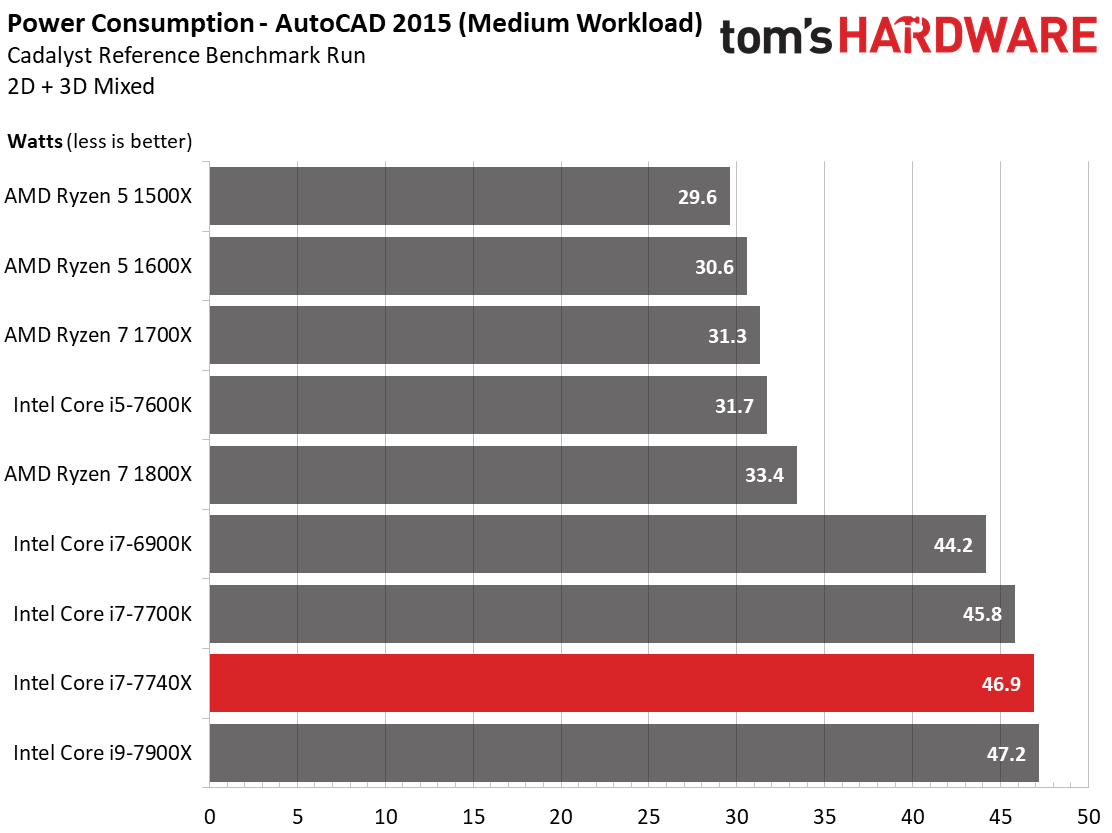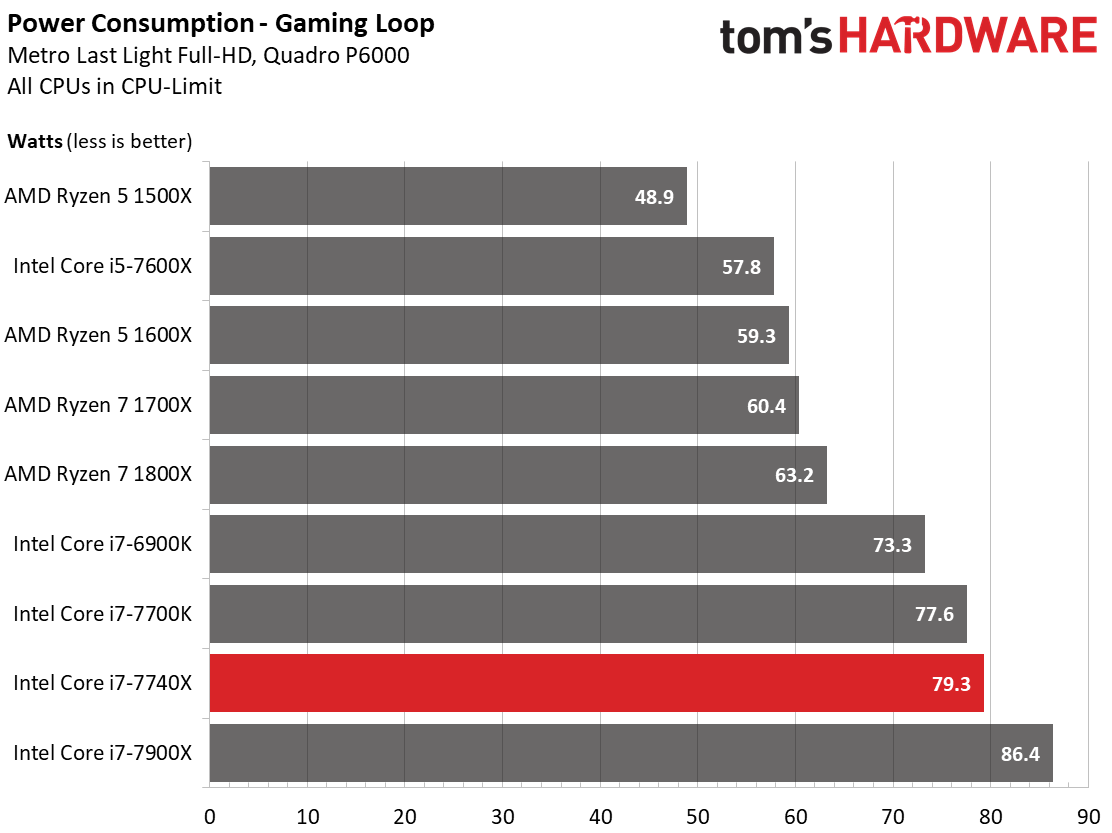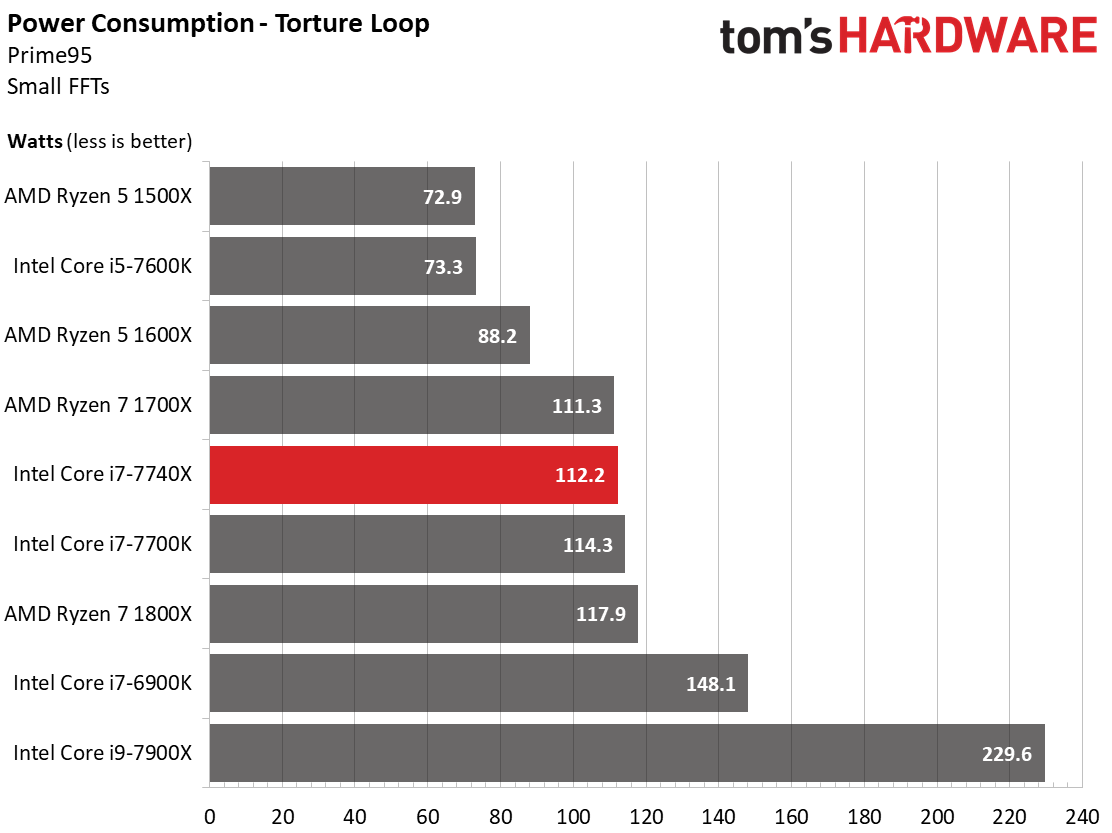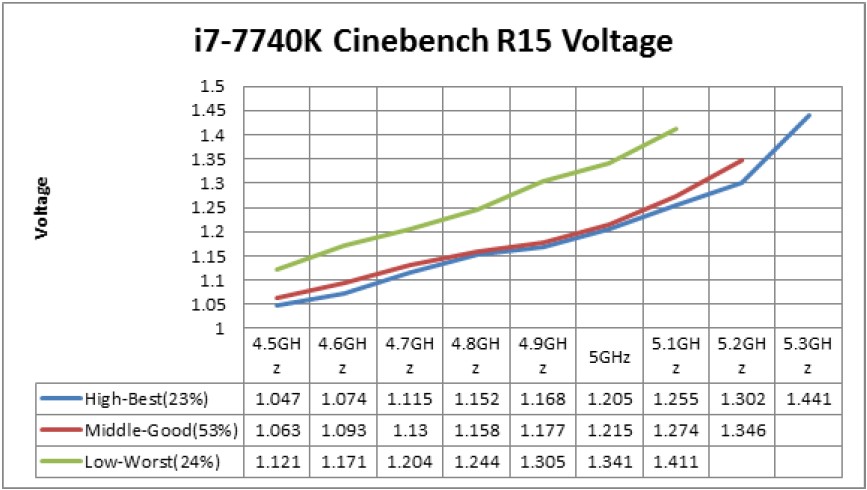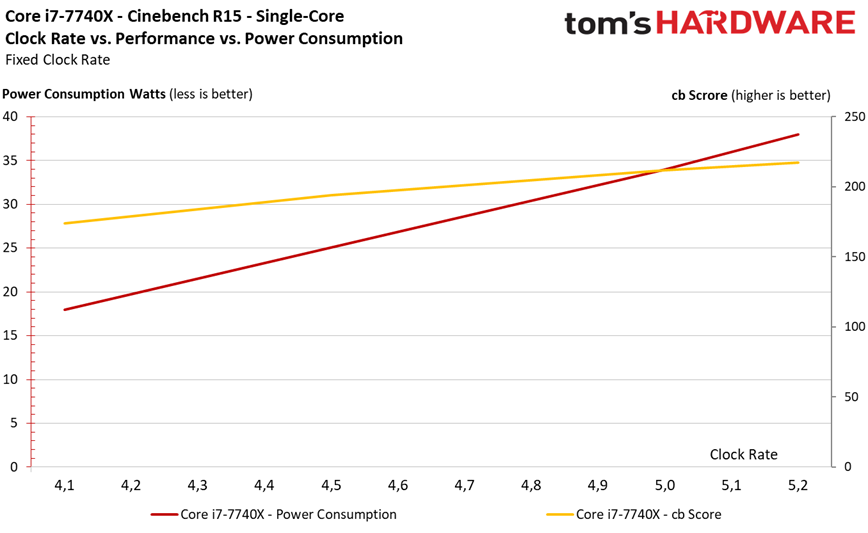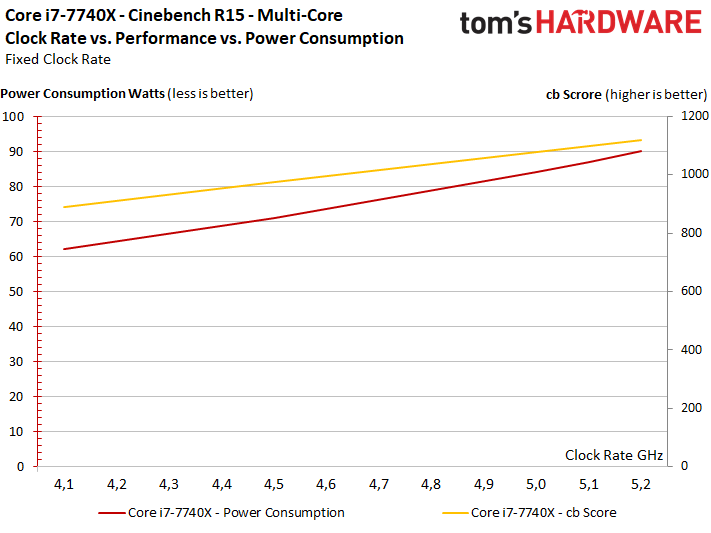Intel Core i7-7740X Kaby Lake-X Review
Why you can trust Tom's Hardware
Power Consumption & Overclocking
Intel isn't using a soldered integrated heat spreader (IHS) for Skylake-X and Kaby Lake-X. Instead of the metallic solder most enthusiasts want to see, heat moves from the die to the IHS through inexpensive thermal interface material, which is just a fancy name for common thermal paste. This decision has implications for both our power consumption measurements and overclocking efforts. Fortunately, in light of the lower amount of waste heat produced by Core i7-7740X compared to Core i9-7900X, this isn't as much of a problem.
In order to produce comparable results, we used our industrial-grade Alphacool Eiszeit Chiller 2000 cooler that was needed for the Skylake-X review. A decent all-in-one liquid cooler would have been fine, though.
Power consumption is measured after the voltage converters and CPU, using points on the motherboard. These numbers need to be part of the equation for sizing your PSU. And depending on the motherboard you pick, they can differ by up to 30W. Consequently, our numbers are for the CPU only.
Power Consumption
At idle, Intel’s new Kaby Lake-X model does a lot better than -7700K. It also pulls ahead of AMD's Ryzen processors. Most likely, a lot of this is due to the disabled HD Graphics engine.
AutoCAD 2015 doesn’t stress CPUs all that much, since it can't fully utilize their available resources. Still, Intel’s Core i7-7740X consumes more power than its predecessors. Admittedly, the difference isn't huge. However, it is larger than our measurement error range and completely reproducible.
The situation is similar in our gaming workload. Interestingly, the average frame rates are almost identical as well.
The stress test produces somewhat surprising results. Intel’s Kaby Lake-X model edges out the -7700K. We don't know why the pattern reverses under full load. However, the delta is almost imperceptible in the 2W range.
Get Tom's Hardware's best news and in-depth reviews, straight to your inbox.
Overclocking & Stability
Does a larger heat spreader and disabled graphics engine yield a meaningful advantage to Core i7-7740X's overclocking headroom? Before we start tweaking, we’d like to provide some background by showing a graph based on a motherboard manufacturer’s binning program. The voltages needed for Core i7-7740X are very informative:
The Core i5-7640X we'll be reviewing soon made it all of the way to 5.1 GHz, putting it in the middle of the pack. In other words, we have a thoroughly average sample.
We tested for stability at every frequency step using Cinebench R15, The Witcher 3, LuxRender, and Battlefield 1. Notice the deliberate exclusion of the AVX-heavy Prime95.
The Core i7-7740X's curve stays fairly straight, which means that power consumption doesn’t explode as clock rate goes up. Rather, the CPU chugs along until it just quits all of a sudden.
A closer look at the performance and power consumption curve shows that performance scales in an almost completely linear fashion with frequency, whereas power consumption increases faster, but not extremely so. Relating single-core performance to the necessary power yields a very similar picture. The resulting waste heat isn’t as bad as some might have feared. At 5.1 GHz, we’re looking at 90W. A good closed-loop liquid cooler should be able to handle this.
In spite of our sample being average, it yielded a good overclocking experience, especially since performance gains and power consumption increases never drifted too far apart.
MORE: Best CPUs
MORE: Intel & AMD Processor Hierarchy
MORE: All CPUs Content
Current page: Power Consumption & Overclocking
Prev Page Workstation & HPC Performance Next Page Temperature Curves & Delta Values
Paul Alcorn is the Editor-in-Chief for Tom's Hardware US. He also writes news and reviews on CPUs, storage, and enterprise hardware.
-
AgentLozen I'm glad that the option for Kaby Lake is available on the x299 chipset. In practice it seems impractical. This article shows you have to pay a lot more for slightly higher overclocking potential.Reply
I'm curious what Intel's plans are for next year regarding their high end desktop chips. They've already used the Kaby Lake X name for this generation. Should we expect Kaby Lake X 8900X? -
Kaz_2_ Intel high power consumption is not great in thr long run. You want the best for your investmentReply -
TJ Hooker ReplyThe curve below shows clearly that waste heat isn't dissipated quickly enough. Just as we did in our AMD Ryzen and Intel Core i9 launch articles, we used a very thin copper plate to measure the heat spreader's temperatures as well.
Why aren't there any numbers/divisions on the horizontal axis? Also, you say you did the same thing for the Ryzen reviews but I didn't see a similar graph in those articles (might just be blind though).
-
the nerd 389 How does the thermal performance of this chip compare to the 7700k? Specifically, does the larger surface area of the heat spreader give you a meaningful increase in thermal conductivity between the die and the heatsink?Reply -
rantoc Dang intel seem to be doing yet another stupid move with X299 beside rushing it out the door making the AMD's pretty brand new architecture/platform appear mature in comparison. As for this move - What's the incentive to pay premium for the X299 when getting a chip like this that won't even utilize it fully? The 7700k and platform are equal in performance in most tests and far cheaper...Reply
With the poor thermal transfer between the core and heat-spreader the retail chips won't likely even overclock well either. Never cared about the cherry picked "reviews" chips at all when it comes to overclocking as they very rarely represent the retail chips. -
rantoc What's the incentive to buy an expensive motherboard and yet get near zero of it's true potential with this cpu? That's paying for a lot of real estate that can't be used at all and on top of that the same poor thermal transfer between the core and heat-spreader meaning a good stable oc is harder to obtain and far less likely to happen on the retail IE non-review cherry picked ones.Reply
I think intel shoot themselves in the foot by scaling this one down to much and then couple it with an overpriced platform for what you get out of it, x299 will be good no doubt but only with the right chips and only when the rushed out of door bugs been fixed. -
This is awesome setup because you can buy x299 motherboard for $219 dollars already which gives you amazing room for later upgrade and this CPU can run 5.0Ghz easily producing very little heat. People at Toms Hardware completely missed the point. I'd rather get $219 x299 motherboard than outdated Z270 for $160.Reply
